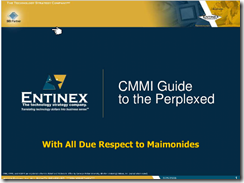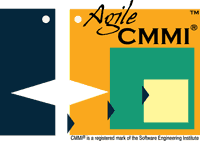The team room of a truly lean/agile company doing CMMI in a way that is natural to them and authentic. They are doing CMMI in an agile way. They know no other way to do it. They went from "what is CMMI?" to ML2 in 14 weeks. Their commitment to lean gave them an edge many companies wish they had: a culture of value and excellence.
What does "truly agile CMMI" look like?
Well, it looks like a commitment to adding value, for one. It looks like delivering incrementally and using each incremental deliverable to iterate, learn, reflect, and continuously integrate into the whole.
It looks like questioning everything that you don’t understand until you do, and then basing decisions on what will provide the most benefit without adding unnecessary features, functions, or work. It also looks like being true to your collaborative nature, to your culture of learning, to your behaviors of communication and transparency. It looks like using measures to know where you are and how well you’re doing. It looks like a commitment to to doing nothing for the sake of doing it — either it has a benefit that you can reap, or it’s not done. It looks like building practices into what you do in a way that eliminates the need for waste-riddled, ceremonial audits later.
When every effort has a purpose that you can tie to a business benefit; when every task delivers something someone needs or wants; when you create a system that people want and use, that you don’t have to pull teeth to get people to adopt and provide you feedback on; that not only flows with and follows in-line with your natural ways of working but promotes new ideas and ways of changing your work regularly and distributing those ideas to everyone who wants to know…. when not a single result of some effort exists whose only reason to exist is to provide evidence for an appraisal….
*THAT’S* what truly agile CMMI looks like.
It’s not just in the processes that result from using CMMI, but also in the manner in which those processes were created.
You don’t "do CMMI" in an agile way when you’re a stogy traditional-oriented organization, and you don’t achieve an agile CMMI when your implementation approach is traditional. If you’re an agile organization, incorporate CMMI in an agile way. Don’t abandon agile values and principles to implement CMMI. Exploit your agile values and principles to implement CMMI in a kick-ass way.
CMMI in an agile way, an agile approach to CMMI, and a seamless blending of CMMI with agile approaches doesn’t happen (easily) if your approach to AgileCMMI isn’t lean and agile.

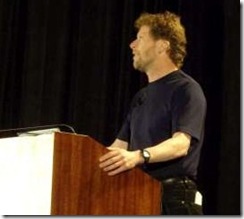 San Jose, CA. Behold:
San Jose, CA. Behold: 
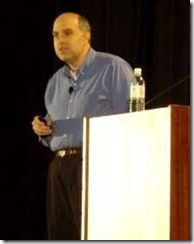
 obstacles). TSP provided a means of measuring the effort and using that data to negotiate better expectations. (Both Alistair and Jim noted the importance of metrics to transparency and improvement.) Jim also took questions including why to wrap TSP in Scrum. Reasons: (1) Product owner, and (2) defined "done" at each iteration. It turns out that TSP came to Adobe, not because of Jim bringing it rather because people at Adobe heard the great TSP stories coming from Intuit and "want sum’dat!"
obstacles). TSP provided a means of measuring the effort and using that data to negotiate better expectations. (Both Alistair and Jim noted the importance of metrics to transparency and improvement.) Jim also took questions including why to wrap TSP in Scrum. Reasons: (1) Product owner, and (2) defined "done" at each iteration. It turns out that TSP came to Adobe, not because of Jim bringing it rather because people at Adobe heard the great TSP stories coming from Intuit and "want sum’dat!" 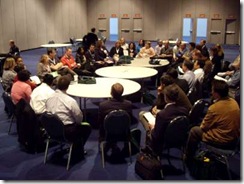 A first for SEPG, was the inclusion of time between the morning’s keynotes and lunch for very user-group-esque "peer to peer" sessions. Conference participants self-selected into table-top discussions driven by other attendees, not selected by the conference program. In fact, attendees put up topics and volunteered to lead them — or put up topics in hopes of someone else showing up to lead and play subject-matter-expert. To no-one’s surprise,
A first for SEPG, was the inclusion of time between the morning’s keynotes and lunch for very user-group-esque "peer to peer" sessions. Conference participants self-selected into table-top discussions driven by other attendees, not selected by the conference program. In fact, attendees put up topics and volunteered to lead them — or put up topics in hopes of someone else showing up to lead and play subject-matter-expert. To no-one’s surprise,  maturity and how Kanban can facilitate it that. But describing it that way makes it sound like it was a commercial for Kanban. It wasn’t. It was about culture’s and measurement’s roles in maturity of development, productivity, quality and production management. How the data drives the actions of the teams and these actions can be demonstrably linked to things that can actually be managed. One way to summarize is in how he said, that "level 5" results are achievable by setting expectations of level 5 behavior as a matter of culture. It’s telling that David’s session spanned 2 normal sessions. People had the opportunity to leave mid-way and go to other sessions. Despite other session opportunities, there was a net gain of attendees in David’s session.
maturity and how Kanban can facilitate it that. But describing it that way makes it sound like it was a commercial for Kanban. It wasn’t. It was about culture’s and measurement’s roles in maturity of development, productivity, quality and production management. How the data drives the actions of the teams and these actions can be demonstrably linked to things that can actually be managed. One way to summarize is in how he said, that "level 5" results are achievable by setting expectations of level 5 behavior as a matter of culture. It’s telling that David’s session spanned 2 normal sessions. People had the opportunity to leave mid-way and go to other sessions. Despite other session opportunities, there was a net gain of attendees in David’s session.